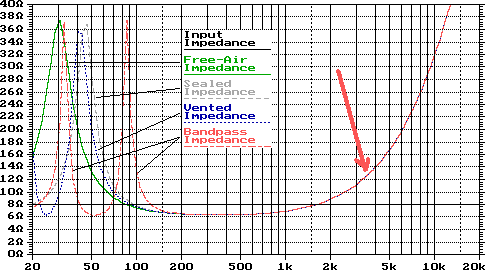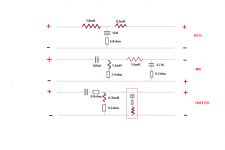I have read and studied that the Zobel will create a flat impedence curve making the XO circuit perform as designed.
How do you decide if it is warranted to have a Zobel on either tweeter or woofer ?
I would assume that if your XO point is suficiently high on the tweeter (above the resonance freq) then you may not need one?
On the woofer, would you say that if you XO point is low enough such that there is little rise in the eimpedence at that point you can get away with out it ?
Thanks in advance.
How do you decide if it is warranted to have a Zobel on either tweeter or woofer ?
I would assume that if your XO point is suficiently high on the tweeter (above the resonance freq) then you may not need one?
On the woofer, would you say that if you XO point is low enough such that there is little rise in the eimpedence at that point you can get away with out it ?
Thanks in advance.
The most compelling reason to use a zobel on a passive crossover network is to provide a flat impedance as seen by the amplifier. Especially with tube outputs with little to no feedback, performance of the amplifier is optimized with a flat impedance vs frequency.
That's my understanding.
That's my understanding.
Suppose I have a woofer whos impedence curve rises as the frequency rises (I think this is typical). Suppose that I choose an XO point far to the right within that area.
Also, suppose I have not used a Zobel circuit.
What is the effect? Will volume increase as the frequency increases towards the XO point?
Also, suppose I have not used a Zobel circuit.
What is the effect? Will volume increase as the frequency increases towards the XO point?
As has been mentioned before, a zobel network is used to counteract the impedance rise created by the inductance of the voice coil.
A zobel network is basically another tool a designer has available to help them to shape the acoustic output of the driver via the crossover.
If you need one or not depends on the driver/s being used.
That being said, textbook crossover calculators assume a perfectly flat impedance and perfectly flat frequency response.
If you were working with a wide bandwidth driver that was reasonably flat..
http://www.tymphany.com/832873
..one of those for example. And you decided you wanted your crossover frequency to be at 2khz. Obviously this drivers frequency response extends well beyond that point. If you were to put a text book 4th order electrical slope into practice, you'd end up reasonably close to your desired 4th order acoustic goal.
But you can go one step further and that's to apply a zobel network across the drivers terminals. The effect will be to flatten the drivers rising impedance thus making the text book crossover see the impedance it was designed to work with as well as a flat frequency response, getting you one step closer to your goal.
A zobel network is basically another tool a designer has available to help them to shape the acoustic output of the driver via the crossover.
If you need one or not depends on the driver/s being used.
That being said, textbook crossover calculators assume a perfectly flat impedance and perfectly flat frequency response.
If you were working with a wide bandwidth driver that was reasonably flat..
http://www.tymphany.com/832873
..one of those for example. And you decided you wanted your crossover frequency to be at 2khz. Obviously this drivers frequency response extends well beyond that point. If you were to put a text book 4th order electrical slope into practice, you'd end up reasonably close to your desired 4th order acoustic goal.
But you can go one step further and that's to apply a zobel network across the drivers terminals. The effect will be to flatten the drivers rising impedance thus making the text book crossover see the impedance it was designed to work with as well as a flat frequency response, getting you one step closer to your goal.
cbdb said:I thought the Zobel was to help keep the amp stable by ensureing a more constant load for the amp. So if you remove the Zobel your amp might start ringing or even go into oscillation and burn up.
Yes, that is another form of zobel. Different from the one in the topic here.
chasingame said:What are the negatives of using the zobel ?
You could ask 'what are the negatives of using a 3rd order network'. It's simply case of using what's required to reach the target goal.
A disadvantage of the speaker Zobel is that it draws additional current from the amplifier, i.e. lowers the overall impedance.
It also reduces the sensitivity slightly.
But if the crossover cannot be made to achieve the correct slopes, then one just has to accept that the impedance correction (by Zobel) is necessary to get the two drivers to integrate correctly.
It also reduces the sensitivity slightly.
But if the crossover cannot be made to achieve the correct slopes, then one just has to accept that the impedance correction (by Zobel) is necessary to get the two drivers to integrate correctly.
Zobels are usually as cheap as a bipolar capacitor and a ceramic resistor, and can be added or removed from a crossover quite easily.
It'll probably cost you a few dollars at most, so it's worth a try. If you're happy with the results you could even spend a bit more on higher quality components.
It'll probably cost you a few dollars at most, so it's worth a try. If you're happy with the results you could even spend a bit more on higher quality components.
5th element said:
As has been mentioned before, a zobel network is used to counteract the impedance rise created by the inductance of the voice coil.
A zobel network is basically another tool a designer has available to help them to shape the acoustic output of the driver via the crossover.
Nothing works without zobels
At least not to me
But they need to be exactly right
Takes some time to get right
I have removed zobel on tweeter though
I have used it as it seemed to remove some sharpness
Now theres no hint of sharpness without it
And now it seems to have negative effect on phase, on my speaker
As did the paralel resistor in att/pad curcuit on tweeter, but probably related to xo function, as series resistor alone changes tweeter slopes a bit (a raise in tweeter impedance makes the series cap bigger, or should I say cuts lower)
But there could be other issues with a paralel resistor, as with any other paralel component
Paralel components have some negative effect, so I reckon its important that they solve more problems than they introduce
If not exactly right value they make trouble
Ok.....
I have done more reading. Now that I know how to compute a Zobel circuit for two drivers in parallel, my reading tells me that during XO design you treat the driver and zobel as a single "unit", meaning I must now know what its new impedance is (not the published figures divided by two).
So, I have two drivers wired in parallel, with my zobel hooked on it.... How do I test the new impedance that will now factor into my XO design formulas ?
What equipment do I need to do this ?
I have done more reading. Now that I know how to compute a Zobel circuit for two drivers in parallel, my reading tells me that during XO design you treat the driver and zobel as a single "unit", meaning I must now know what its new impedance is (not the published figures divided by two).
So, I have two drivers wired in parallel, with my zobel hooked on it.... How do I test the new impedance that will now factor into my XO design formulas ?
What equipment do I need to do this ?
re:'How do I test the new impedance that will now factor into my XO design formulas ?' - you don't need to;
the main point of a zobel is that it makes the impedance constant across the frequency range...
you use the impedance you used in calculating the zobel parts values (in your case, Re/2 )
the main point of a zobel is that it makes the impedance constant across the frequency range...
you use the impedance you used in calculating the zobel parts values (in your case, Re/2 )
I understand that the goal is a flat impedance. My reading suggests the the driver plus zobel now has a new impedance that can be significantly different.
I was doing some reading here:
http://sound.westhost.com/lr-passive.htm
Here is a quote from this page concerning the application of zobel on an 8 ohm driver:
On calculating my Zobel:
I need Re and Le. I assume I use Re/2 for two drivers in parallel. What about Le ?
Also, what if I do not have the Le (ie was not published by manufacturer). How do I compute it?
I was doing some reading here:
http://sound.westhost.com/lr-passive.htm
Here is a quote from this page concerning the application of zobel on an 8 ohm driver:
The impedance is now commendably flat, but at the expense of overall impedance, which is reduced from the nominal 8 ohms to the real impedance of the tweeter - in this case, about 6 ohms. This figure must be used when the crossover network is designed - not the nominal 8 ohms impedance. This is a very common mistake made by the novice, and from what I have seen, quite a few professionals as well. The nominal impedance is just that - nominal. When designing the crossover, the actual measured impedance must be used - always!
On calculating my Zobel:
I need Re and Le. I assume I use Re/2 for two drivers in parallel. What about Le ?
Also, what if I do not have the Le (ie was not published by manufacturer). How do I compute it?
re'How do I compute it?' - you don't, you measure it.
ARTA http://www.fesb.hr/~mateljan/arta/download.htm
ARTA Jig - http://zobsky.blogspot.com/2008/01/simple-loudspeaker-measurement-jig-for.html
ARTA http://www.fesb.hr/~mateljan/arta/download.htm
ARTA Jig - http://zobsky.blogspot.com/2008/01/simple-loudspeaker-measurement-jig-for.html
- Status
- This old topic is closed. If you want to reopen this topic, contact a moderator using the "Report Post" button.
- Home
- Loudspeakers
- Multi-Way
- Do I need a Zobel ?


